The Paris Olympics officially bring the Emma Hayes era into full gear.
The long-time Chelsea manager, whose side won the WSL over Manchester City on the final day of the season, is two games into her tenure.
She’ll have two additional matches before jumping on a plane for Paris.
Even with the transitional period under Twila Kilgore and limited time in camp, the former UNC Tar Heel has already made tremendous strides with her new side.
In preparation for the Olympics, this tactical analysis will focus entirely on the USWNT’s games against South Korea.
Hayes and her staff, which includes former Total Football Analysis analyst Cam Meighan, have direct contact with the players at this stage and can fully transition to her style of play.
This scout report examines the tactics on display during the South Korea friendlies and gives an idea of what we can expect from the former Chelsea manager.
Predicted starting XI
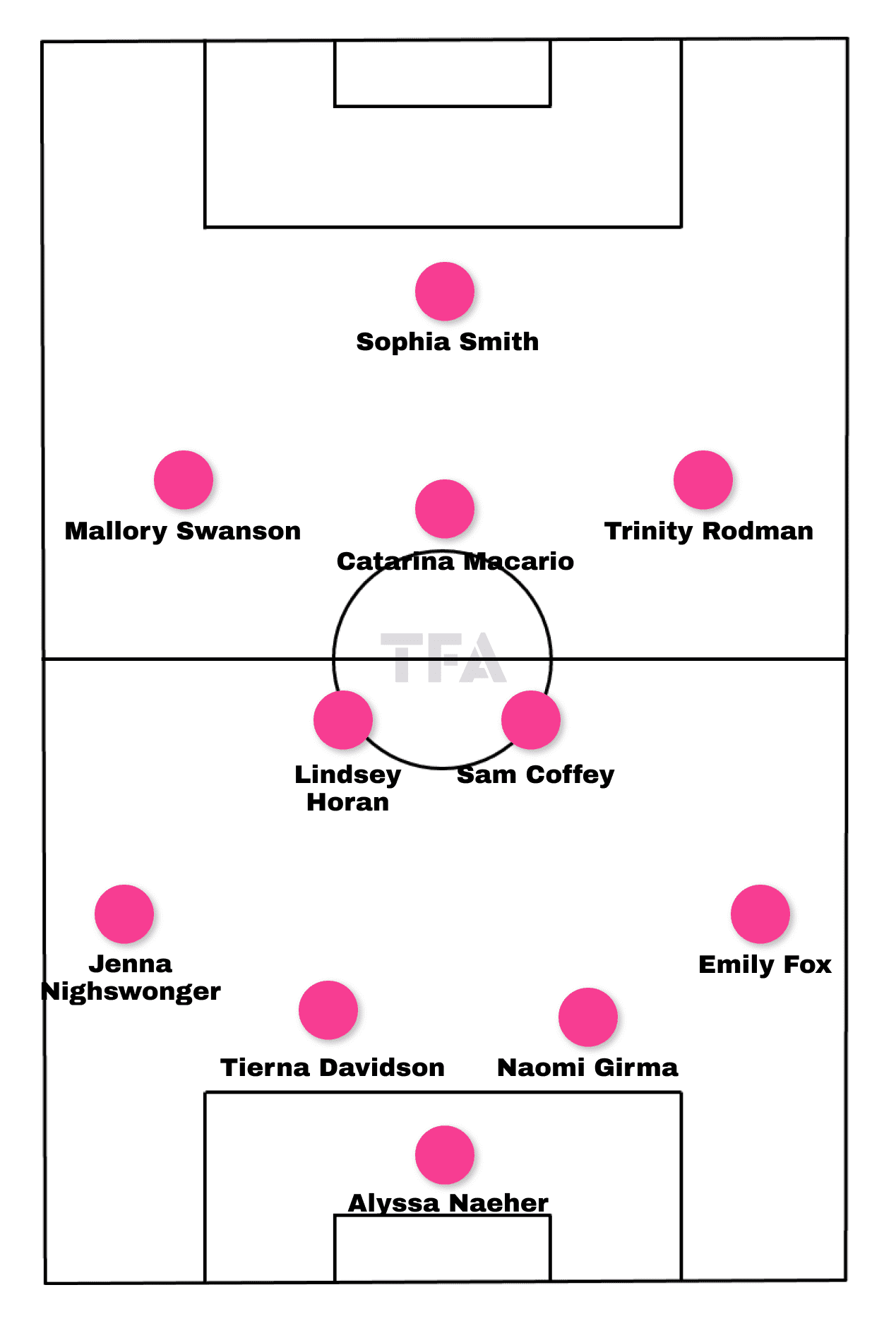
Look for Hayes to use a 4-2-3-1 system with her new side.
Those first two matches give an indication not only of her preferred system but also a hint as to who she might pick in each role.
This is certainly a side with positional locks, such as Naomi Girma at centreback, Sam Coffey and Lindsey Horan at the double pivot, and a front three of Mallory Swanson, Sophia Smith, and Trinity Rodman.
Of this group, Coffey is the one question mark.
An injury sustained in NWSL play saw her leave in walking boot, though the ailment is supposedly not serious.
Tierna Davidson looks the likeliest candidate to partner with Girma centrally.
With USA’s 3-2 setup at the back when in possession, a centreback could fit into that right side to free a player like Jenna Nighswonger on the left, but Emily Fox looked comfortable with that role and is the likeliest candidate to start at right back.
Monitoring Fox’s performances as the right-centreback when the USA is in possession will give an indication of Hayes’ thoughts.
Centre-attacking mid features another interesting battle.
The incumbent and arguably the USWNT’s most creative player in recent years, Rose Lavelle, is locked in a tight battle with Catarina Macario.
It’s a tight enough battle where either player could step into that role.
Look for some degree of rotation at the position, both in the starting XI and with substitutions.
Lavelle may have a slight advantage after strong performances in the South Korea friendlies, but this is a tight battle.
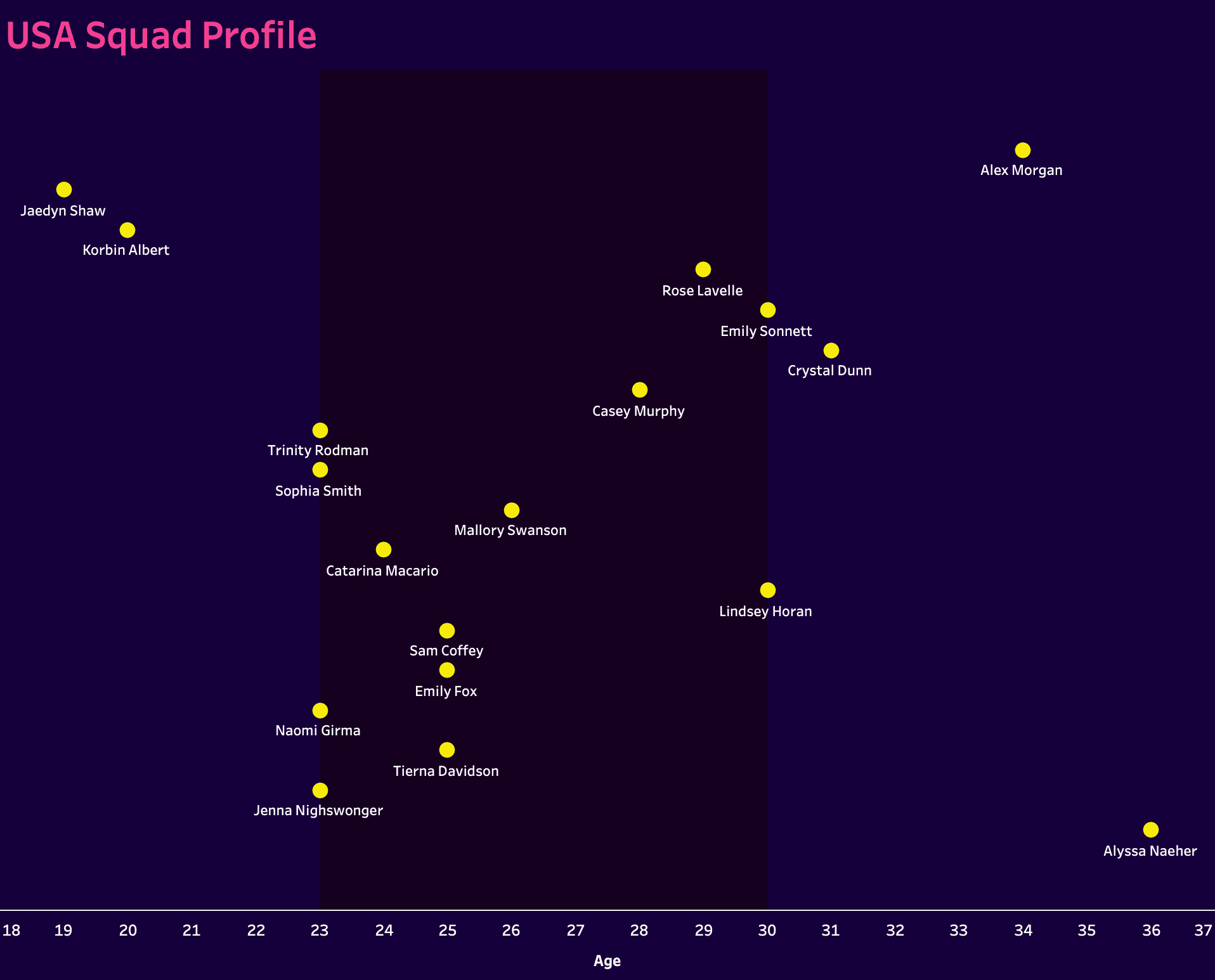
In terms of the squad profile, our projected 18 to make the trip falls mostly within those peak playing years.
Goalkeeper Alyssa Naeher and veteran forward Alex Morgan fall to one end of the chart, with Crystal Dunn, Horan and Emily Sonnett close behind.
Otherwise, this is a young team, signalling the transition from the 2019 World Cup-winning squad.
Some of the possible alternates include a pair of teenagers in 17-year-old Lily Yohannes and 18-year-old Olivia Moultrie.
Attacking phase
Hayes has brought a new look to the USA’s attacking tactics.
With a 3-2 rest defence at the back, this is a side that will frequently set up in a 3-2-5, but they’re also highly adaptable.
If there’s a need to draw the opposition’s outside backs higher up the pitch, they can take on a 3-4-3 look instead.
The depth of the wingers and the visual cues to signal a high, central player dropping into midfield make this a clever group.
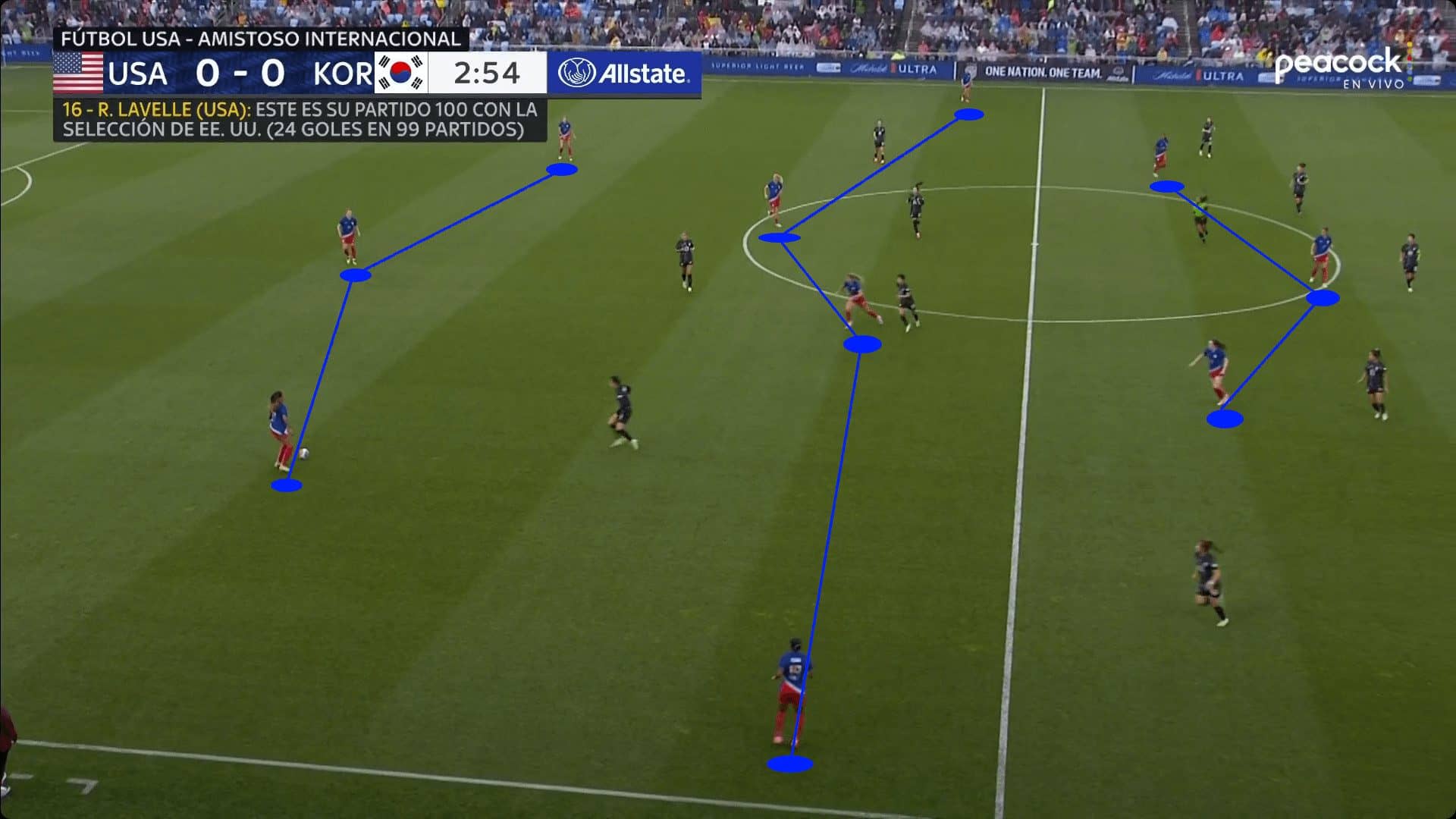
Within the 3-2-5, they’ll look for opportunities to drop one of those high central players into the space between the lines.
This is where Macario and Lavelle come into play.
While any of the attacking midfielders or the central forward can drop into those spaces, it’s often the creative midfielder who takes that initiative.
One other note is that the midfield is very fluid as well.
Coffey will typically remain deep, but Horan has license to rotate positionally with anyone ahead of her.
South Korea dropped into a mid-block, often with a midfield line of confrontation, so the USA’s build-out was rarely tested.
What we did see is how this new-look side will create and exploit spaces when up against a mid-block.
With typically one player in the wings and the remaining eight field players keeping more central positions, the USA used that overload to stretch South Korea’s lines vertically, which created pockets of space between the lines.
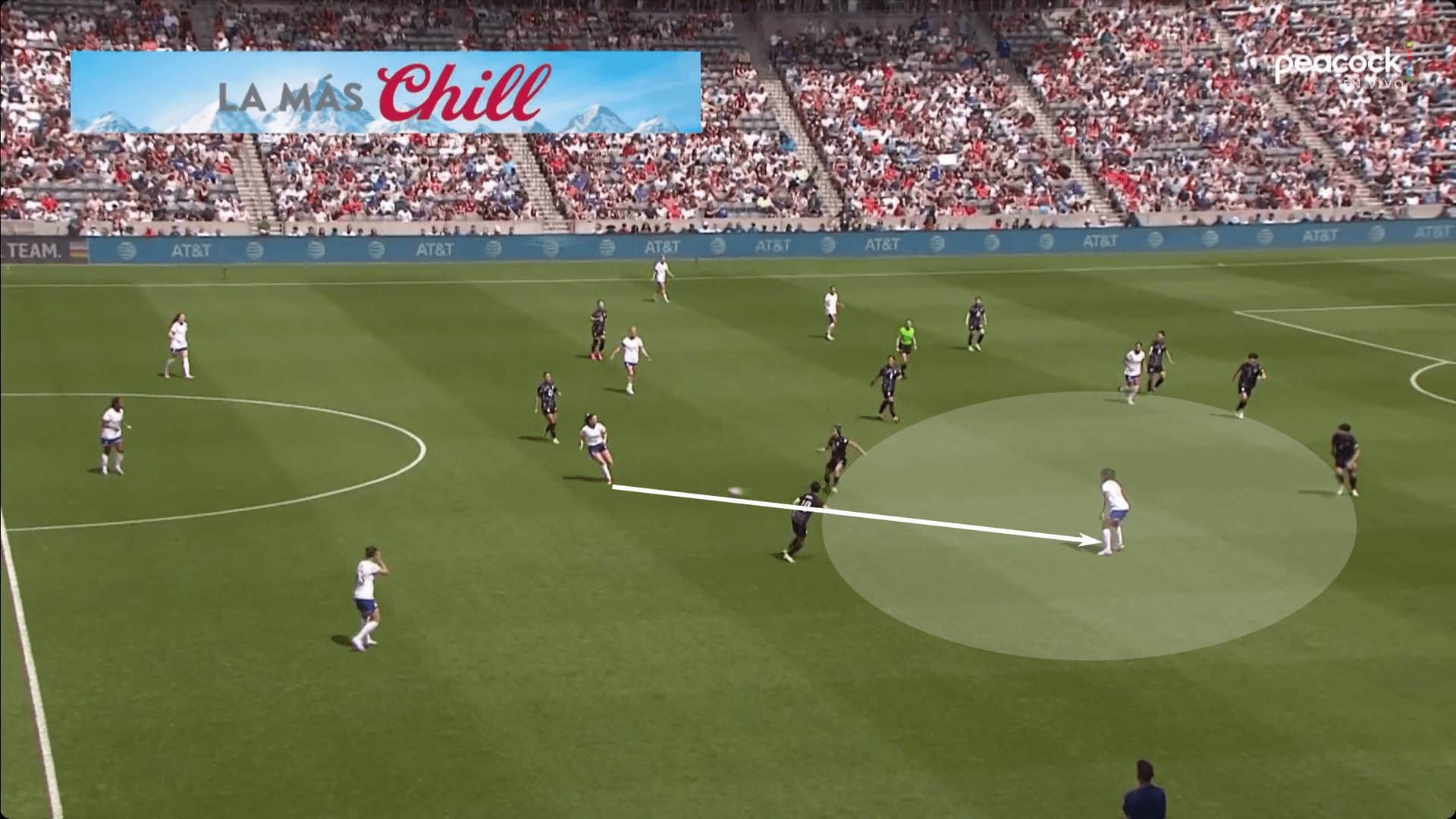
Once the USA entered the final third, those high numbers gave them flexibility in how they could attack the box.
In this instance, it was a nice combination in which Macario played Smith, who tried to lead Rodman into the box.
The final pass wasn’t completed, but it was a great idea and an example of the new look USA’s threat in the final third.
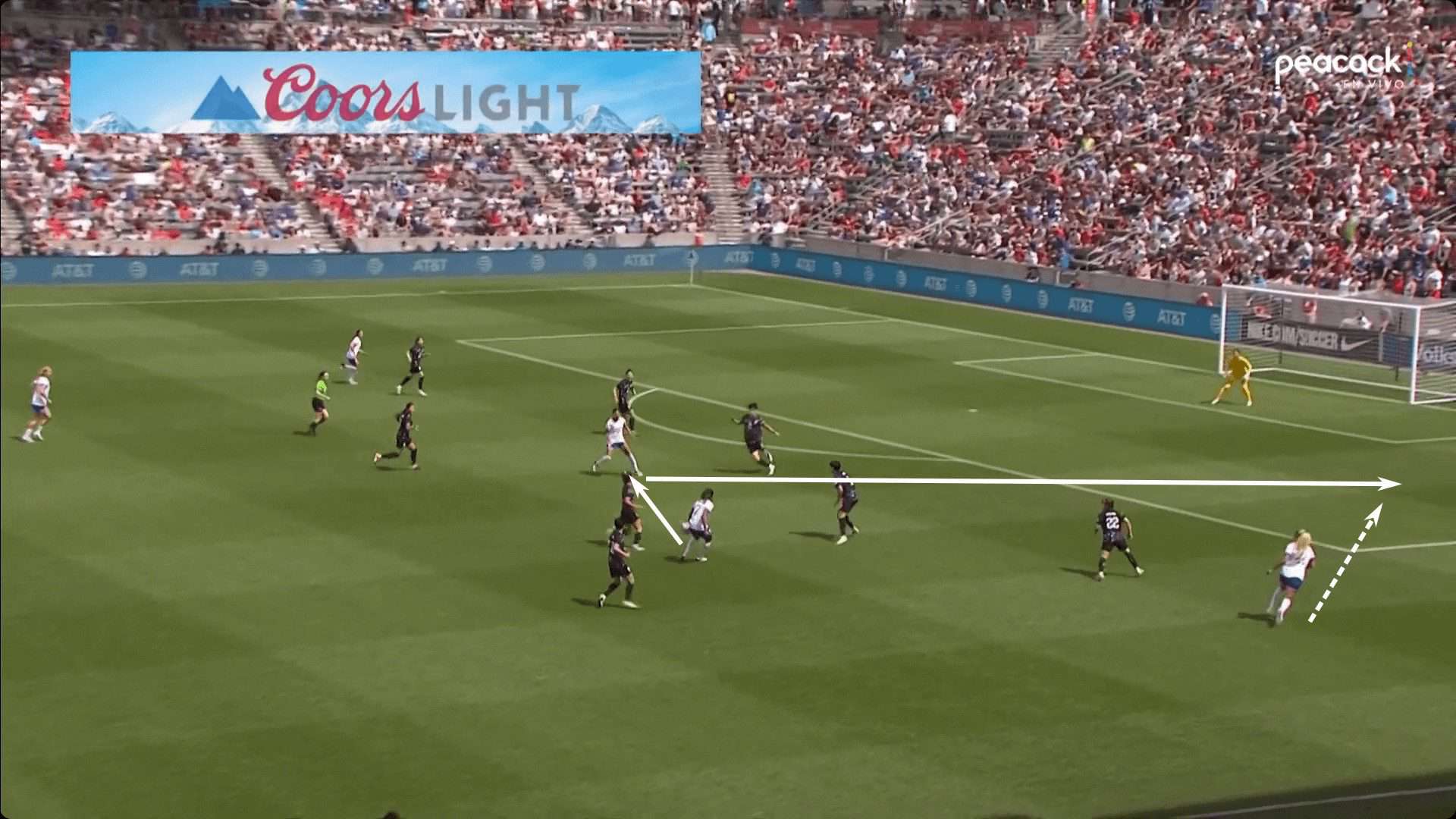
When opponents settle into a low block, a combination of runs in behind and playing off of a high central player helps the USA get through centrally.
While they will generally have a player out wide for the simple pass into a cross, the team showed it has the ability to quickly connect through the middle to beat the low block.
Here, Girma played into Smith who found the run of Swanson for a well-worked goal.
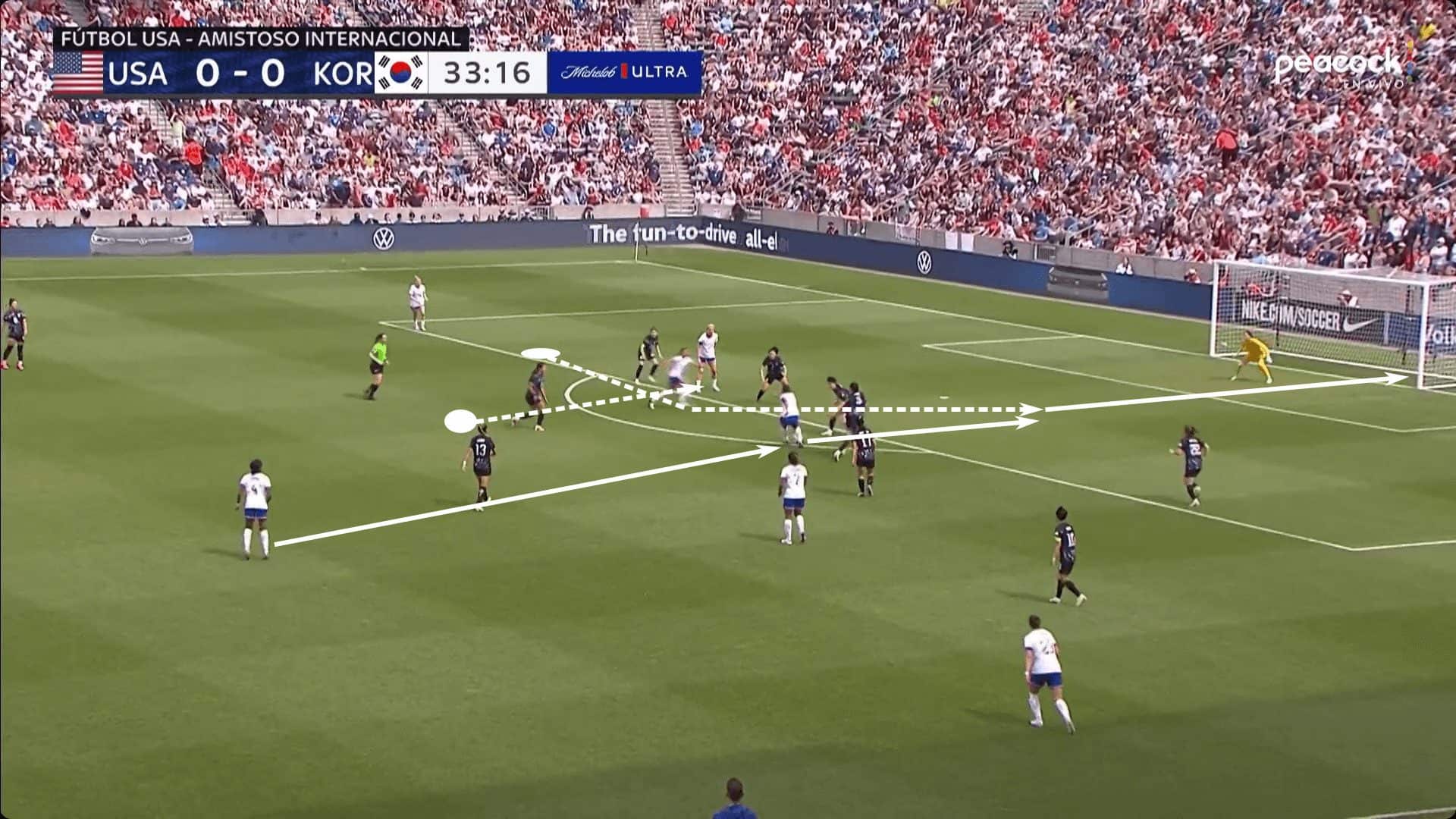
Even though this American side is better equipped to break opponents down centrally and uses collective movements to beat the opponent, they’re still most dangerous when they can run at the backline.
In the first game against South Korea, the fourth and final goal came when Lavelle received between the lines and ran at the Korean defenders.
Her pass to Swanson was a simple one, but that more direct movement produced the goal.
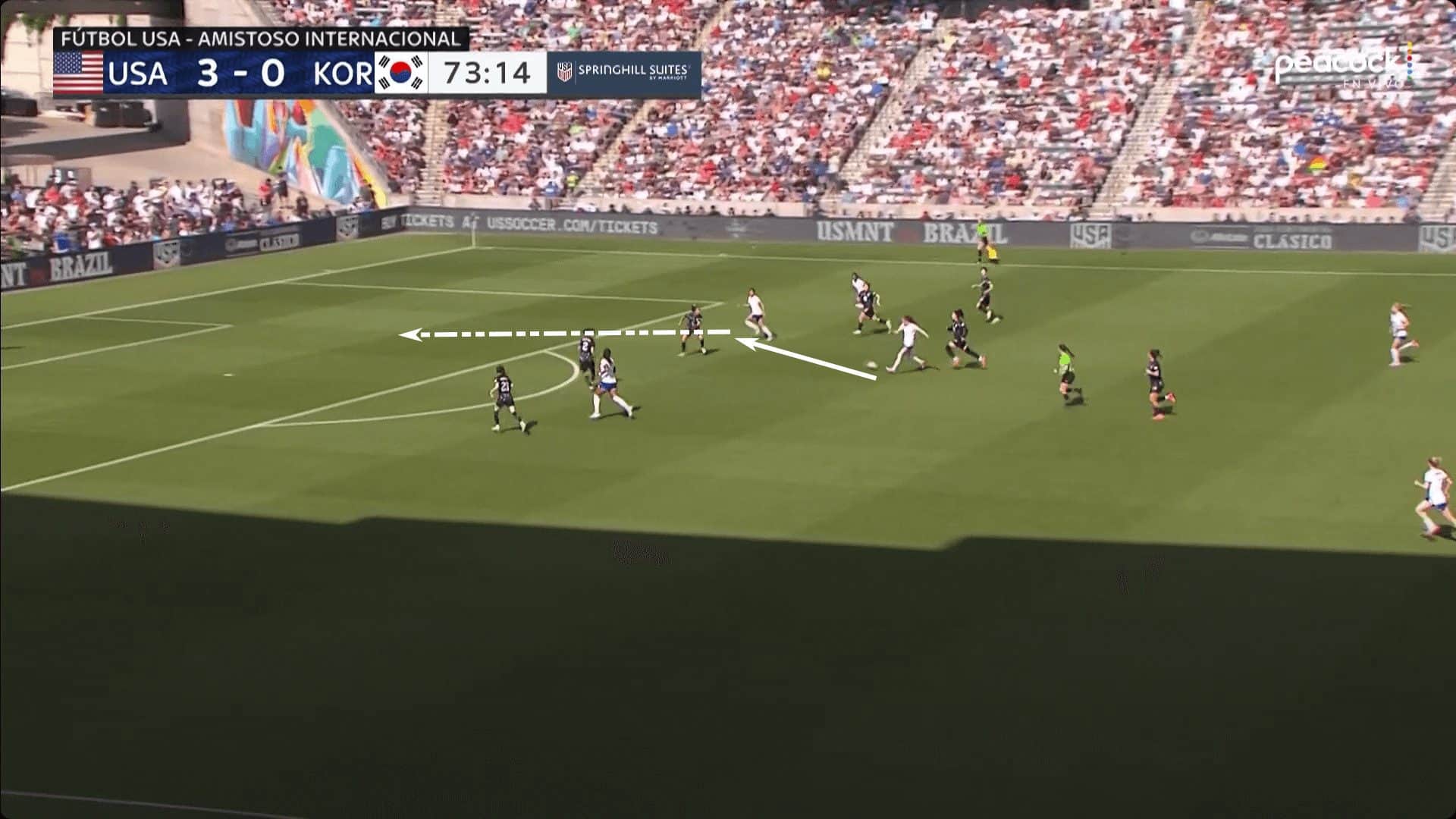
The individual talent is still there, but this is an American side that is growing into a more cohesive, collective style.
Hayes’s game model will continue to evolve as she spends time with her new team, but the early results are very promising.
Defensive phase
With two clean sheets against South Korea, the American defence looked well-organised and ready to deal with the opposition’s attempts to play forward.
The side routinely used a 4-4-2 mid-block as their base setup.
Part of this may be due to the fact that South Korea rarely tried to play their way out of the back.
Could we see an American high press at some point in the Olympics? Definitely, but the early feedback is that the team will sit a little bit deeper.
Within that 4-4-2 setup, it’s the #10 who steps forward to join the #9.
The #7 and #11 will drop even with the pivots and are responsible for tracking as deep as necessary to maintain the team’s defensive shape.
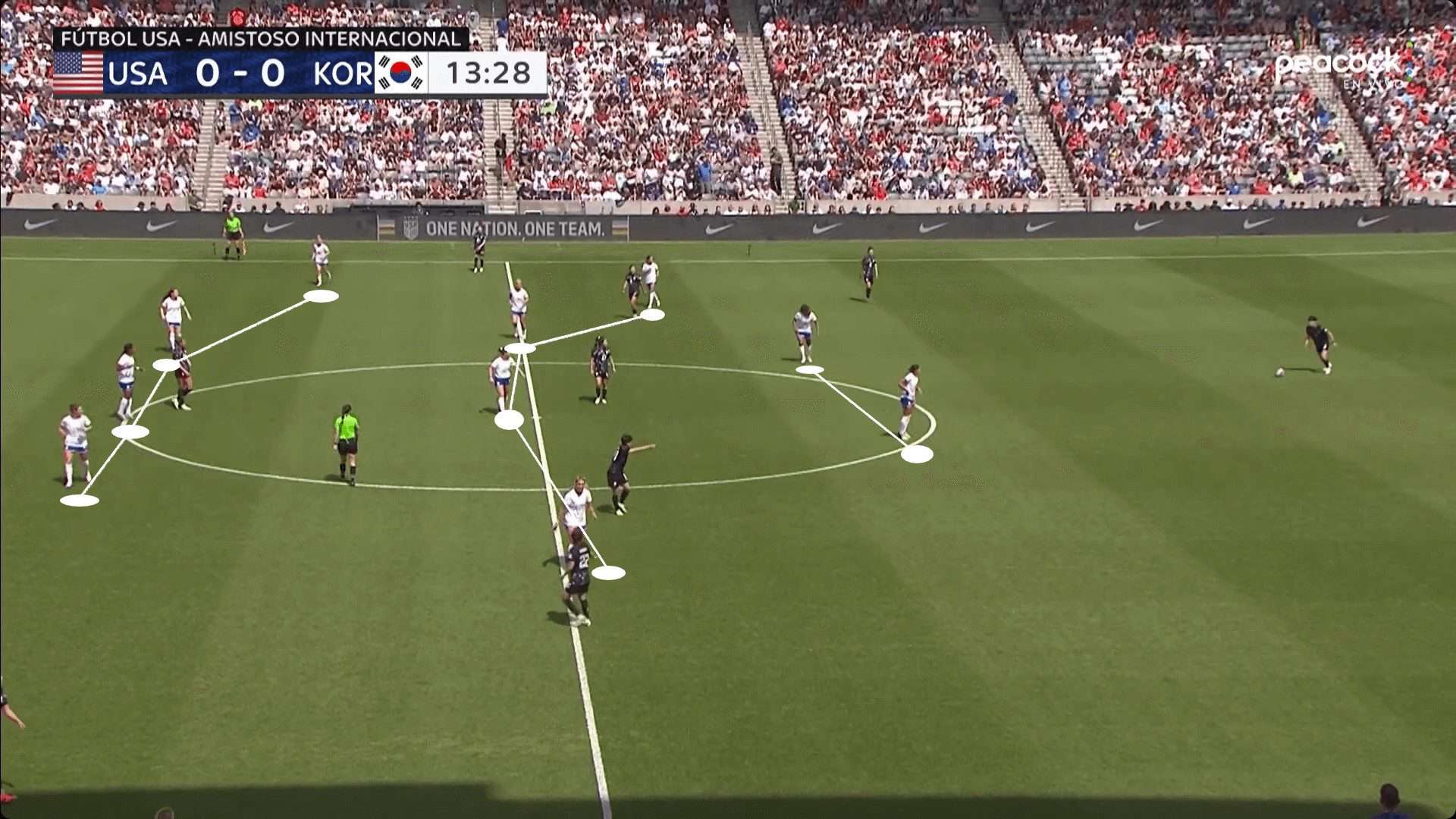
This includes dropping in the box to help defend in a low block.
When South Korea did manage to get numbers up the pitch, the American wingers were quick to drop deep and very disciplined with their approach.
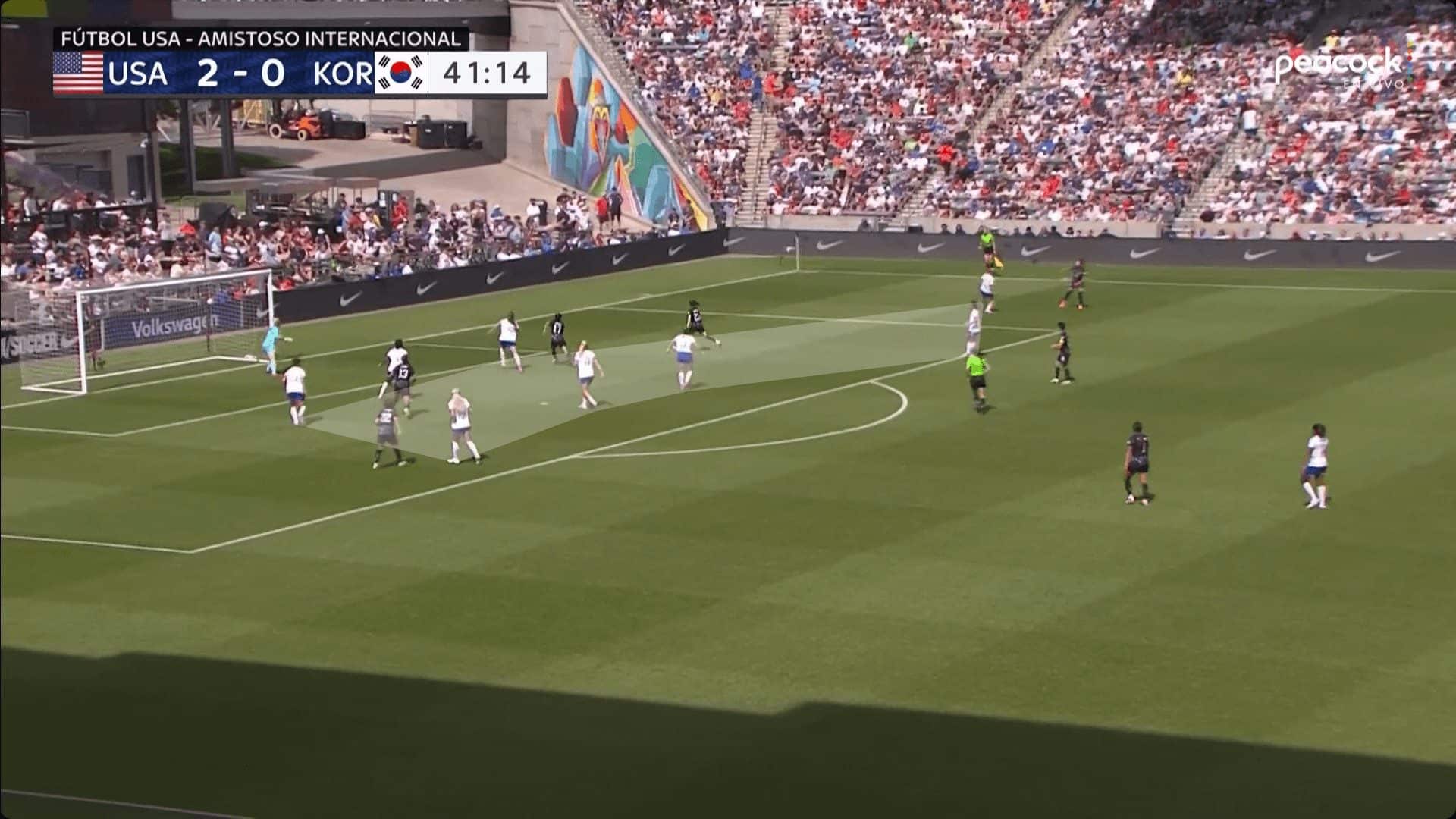
The final sequence in this section comes from a transitional moment, but if we are going to look at what an American high press may look like at the Olympics, this is a pretty good example.
To slow the Korean transition, the USA limited their progress up the pitch.
Three passes in a triangular movement left the Koreans right where they had started the attack.
As we can see with the American approach, they’ve greatly condensed the playing area and have taken a woman–marking approach near the ball.
There are no open short or intermediate options.
If South Korea wants to play out on the ground, they do so at their own risk.

In fact, they did look to play out through the left wing-back.
Lavelle quickly closed space, won the ball and started the American counterattack.
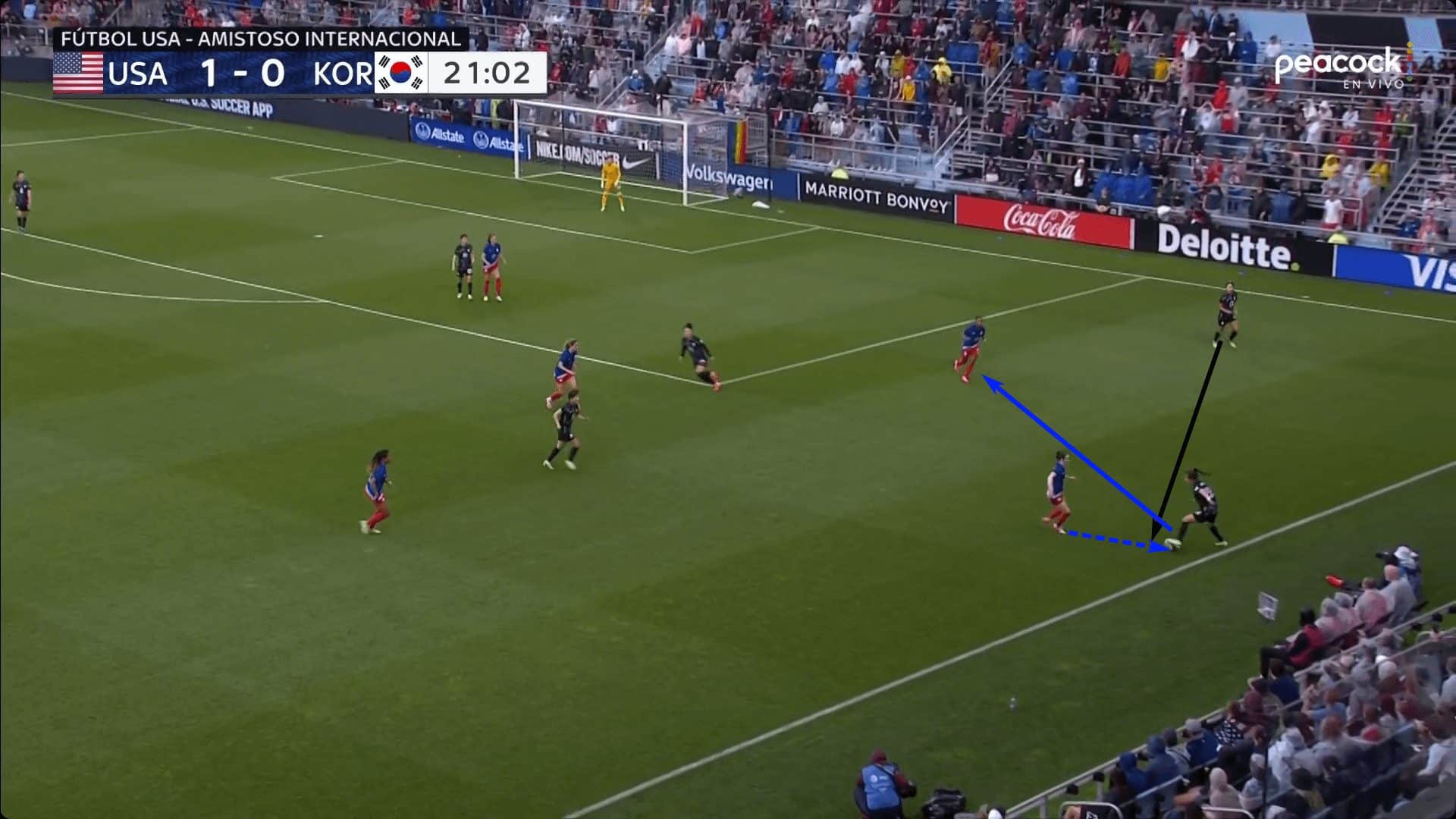
The USWNT’s group stage opponents will offer a different level of threat than the South Koreans, but even against a quality opponent, the American side was difficult to break down and resolute when needed.
It was a quality defensive showing and certainly two games that Hayes will look to build on.
Transitions
The USA’s attacking transitions will be something to watch.
With all the pace and quality they have up top, this group is dangerous.
Zambia will surely sit a little bit deeper, but it will be interesting to see how the Germans and Australians look to contain American counterattacks in more even games.
Before we dig into the USA’s counterattacking tactics, let’s start with their defensive transitions.
They are a side that will counterpress aggressively, but they find a nice balance between counterpressing to win the ball and simply preventing the opposition from playing forward.
When the opponent is able to break the first wave of the counterpress, USA’s rest defence structure can help limit the damage.
We got a good look of how that 3-2 rest defence at the back allows the USA to respond to opposition counterattacks.
They did well to take away the middle and delay the South Korean attack so that the Americans could recover numbers behind the ball.
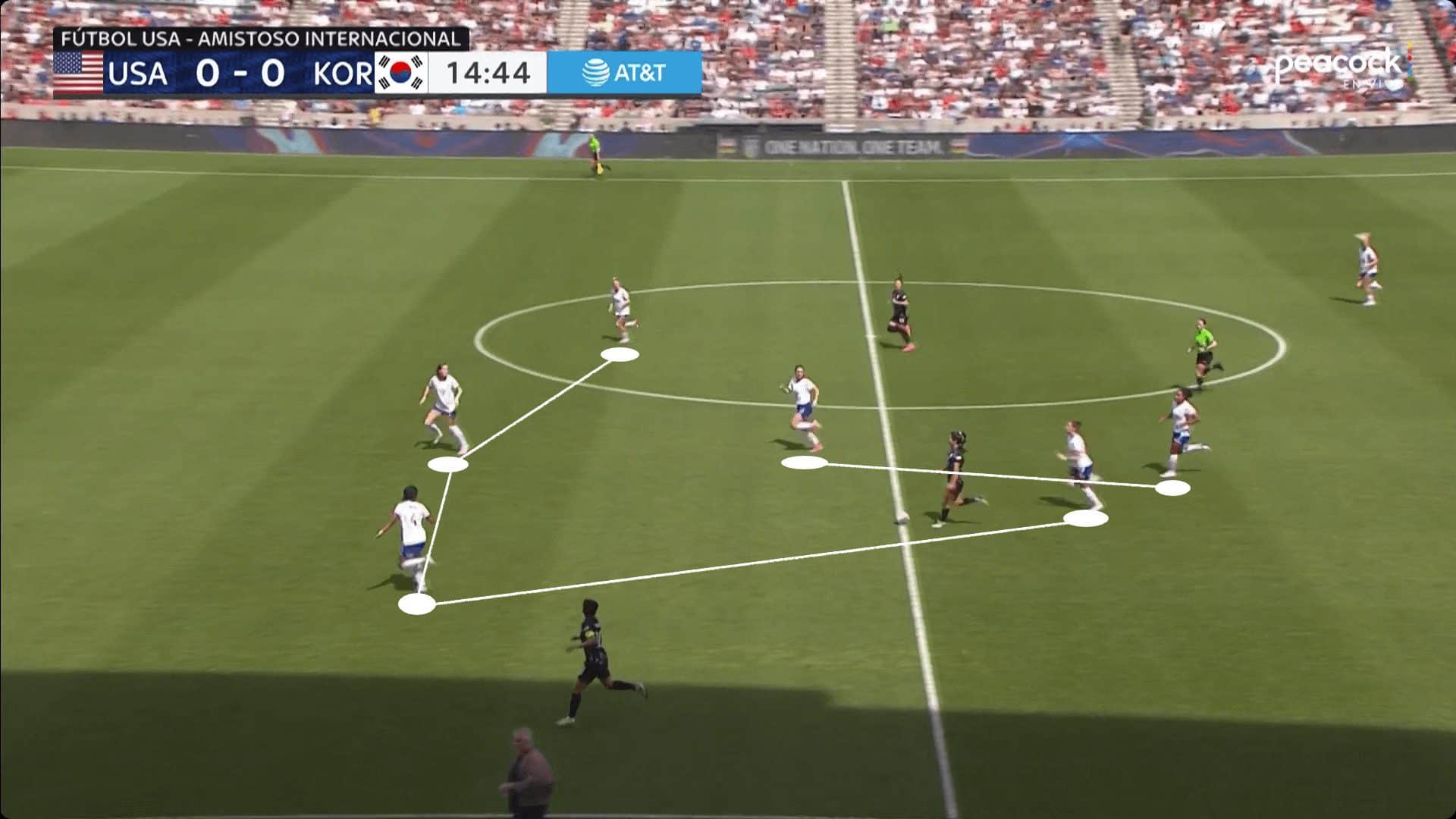
Now, moving to their counterattacking, the USA’s midfield setup in the 4-4-2 press is fairly narrow.
When the Americans win the ball, they always have someone centrally who can exploit open space.
In this example, it’s Horan playing to Swanson, who’s able to run between the lines and dribble at the Korean defenders.
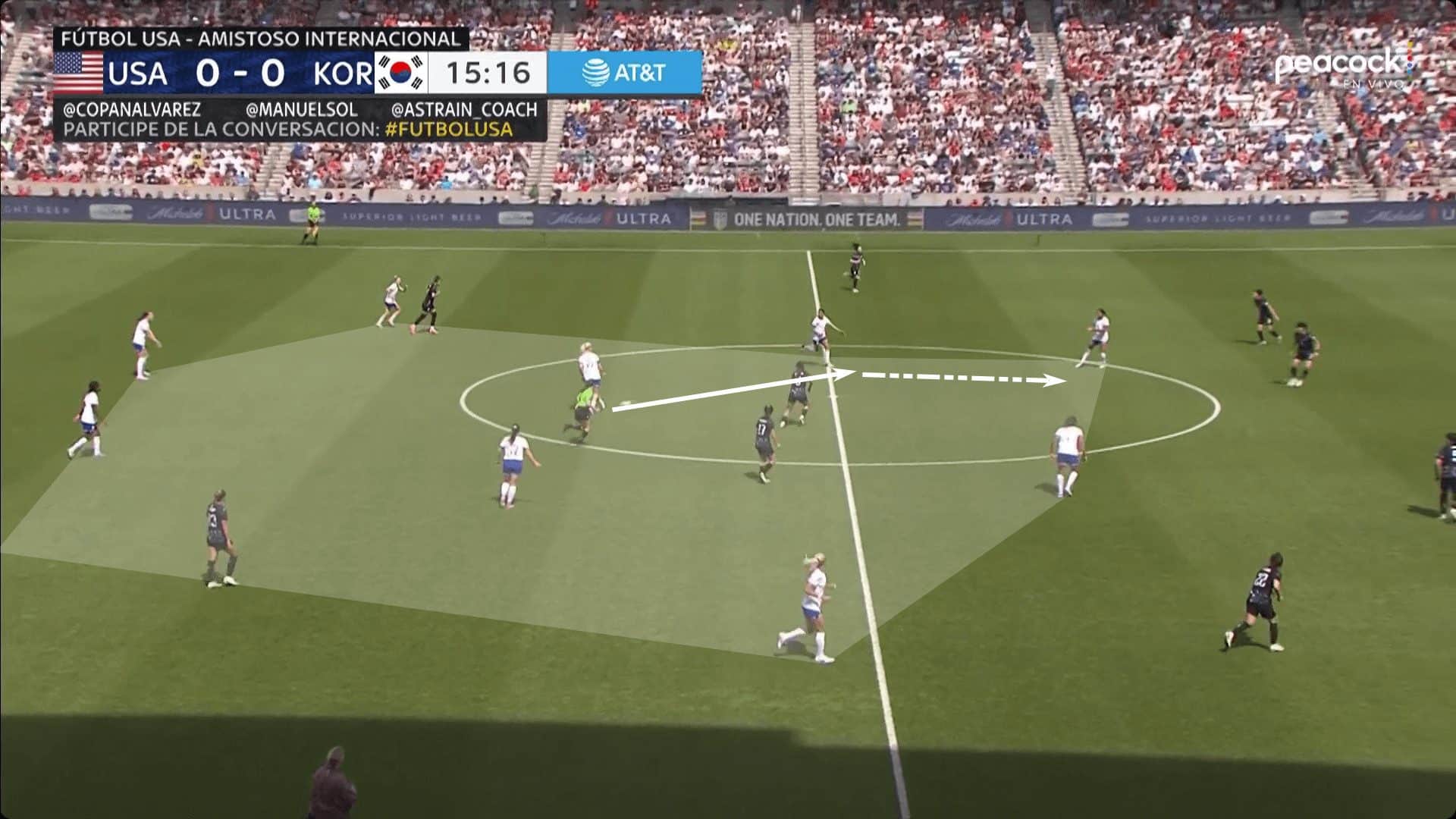
In that second game, Dunn’s goal was set up by a low recovery, and her forward pass to Alex Morgan.
The striker was able to turn and carry the ball up the pitch.
Meanwhile, her teammates rushed forward in support, finding gaps in the Korean press.
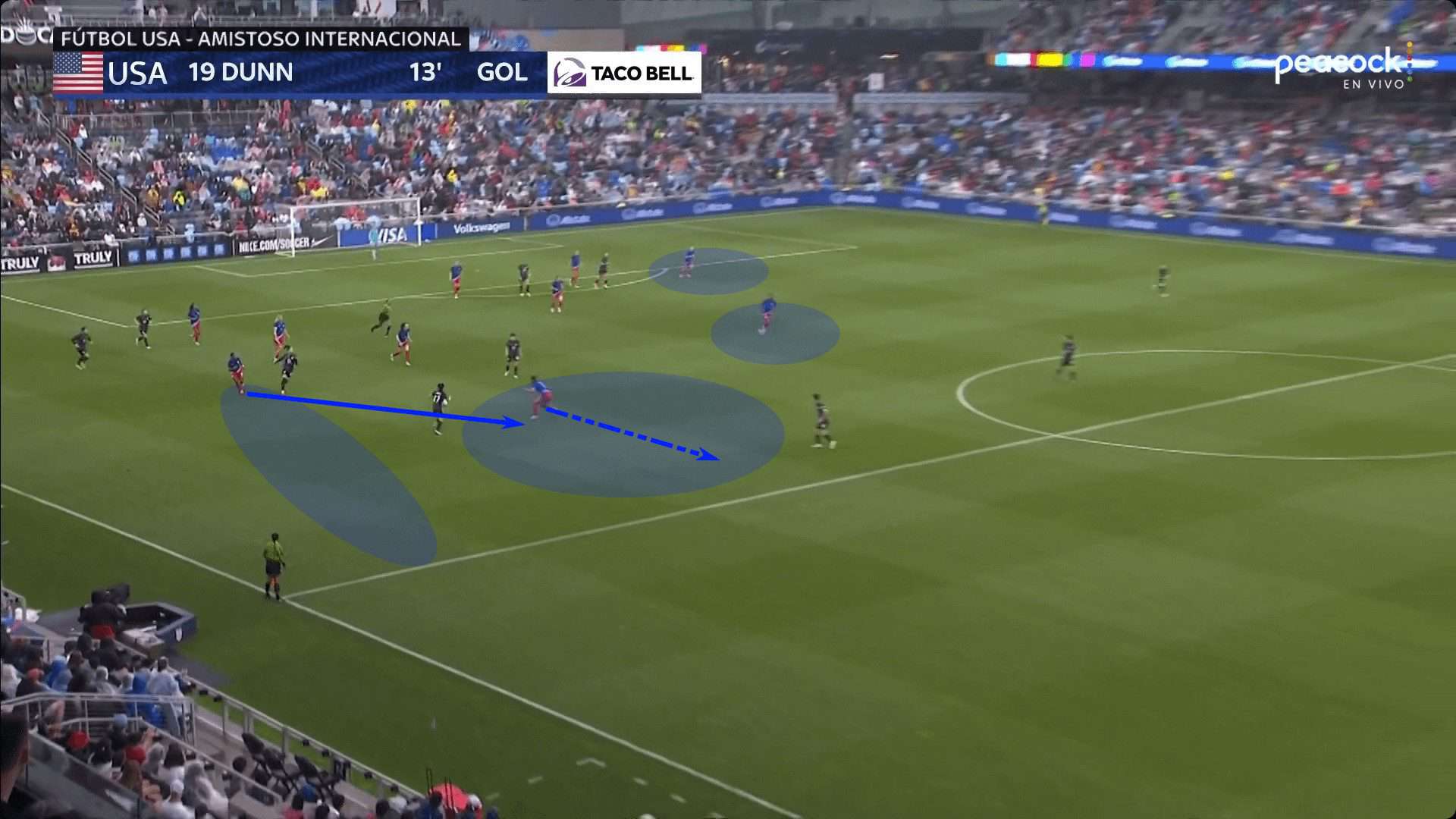
Nighswonger made a brilliant run up the left wing and got herself into a crossing position.
When she sent a cross, the Americans had a 4v3 advantage in the central area of the box, as well as positional advantages at the near and far posts.
It was a beautiful delivery by the left-back, setting up a close-range tap-in from Dunn.
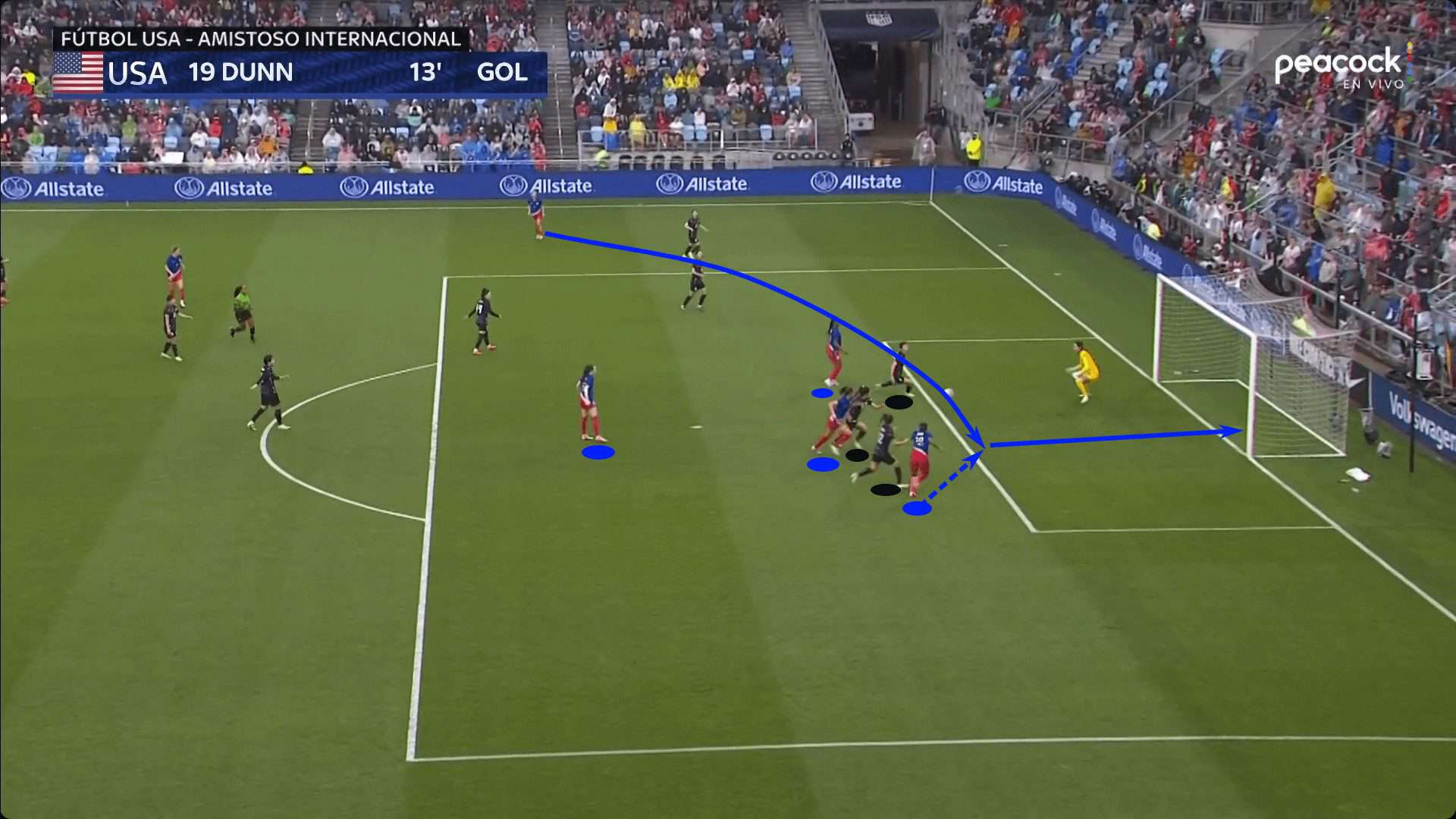
Given the difficulty of the USA’s group and the general strength of the field, the USA’s prolific counterattacking may very well prove decisive in the tournament.
As opponents look to retain more of the ball and commit more numbers up the pitch, they’ll play into the American’s hands, creating the attacking conditions the USA wants.
Keep an eye on this counterattack.
Forwards
The expected front line of Swanson, Smith, and Rodman gives the USWNT a formidable group up top.
All three players can stretch back lines, drop into midfield to receive, and beat opponents 1v1.
Smith and Swanson especially have that box presence and finishing capability, allowing them to be decisive players in each match.
The 18-player roster does limit support up top.
Look for Alex Morgan to make the squad and give the USA a different look up top when she is in.
She’ll offer the holdup play and aerial ability that you don’t get with Smith.
Crystal Dunn figures to factor into the front line as well.
Jaedyn Shaw will likely see some time up top as well.
Olivia Moultrie is our odd player out, but she could very well make the squad as an alternate.
Midfielders
In midfield, Horan, Coffey, Lavelle and Macario are the likeliest to see time.
Korbin Albert offers another strong, young presence in midfield and will get her share of minutes in the tournament.
Much like Dunn’s flexibility to play either as a wide forward or an outside-back, Emily Sonnett offers positional flexibility for the USA, which is vital at the Olympics.
She can play anywhere along the backline or as a holding midfielder.
Look for Hayes to lean on the versatility of Sonnett to close out games and to offer some rotation in the group stages.
There’s some exceptional talent that doesn’t quite make this group.
Veteran Andi Sullivan looks like an outsider at this point but is still a solid option in that double-pivot role.
Lily Yohannes, the teenage Ajax player, also showed very well in the recent friendlies and is certainly in contention for an alternate role, if not the final 18.
Defenders
Girma and Davidson are the likeliest to start at centre back; this is where we can also see Sonnett for the possible addition of Casey Krueger.
Chicago Red Stars’ Sam Staab may also get the nod; if not with the match day team, then certainly the possibility that she is included as an alternate.
At outside-back, Fox and Nighswonger are the likely starters with Dunn offering an option at the back as well.
If Krueger makes the 18, she can also play out wide, which may help her chances of making that final roster.
Backline depth will be the most interesting of Hayes’s selections.
Given that Dunn and Sonnett can play along the backline, she may opt for leaner depth at the back.
In goal, expect Naeher and Casey Murphy as the two to make the 18.
Key player
Our key player is the prolific Sophia Smith.
Portland Thorns’ #9 is a prolific goal scorer and will move back to the centre of the pitch now that Swanson is healthy.
With firepower along the front line, Smith will have the freedom to pick her matchups and use her pace to stretch the opposition’s back line.
A lethal finisher, Smith also moves in the box well, finding pockets of space in the opposition’s defensive setup and using her anticipation and quickness to get into quality shooting opportunities.
She won’t lack service with this group of players and the tactics we’re likely to see from Hayes.
Look for a big tournament from Smith and better production from the frontline in this tournament.
Tournament prediction
This is a tough prediction to make for a team in transition, both with a coaching staff and, to a lesser degree, with some of the players rising to more prominent roles.
The side will certainly look to improve upon their World Cup disappointment.
Getting out of the group is a must, but there simply are no easy games at the Olympics.
Their quarter-final matchup will inevitably pit them against a top-10 team.
By USWNT standards, winning the tournament is the objective.
They should have the strength to reach at least the semifinals, but that’s not the objective.
Only gold will do, even if that means they have to get through a difficult group and the likes of Spain, France, Japan, Brazil, and Canada to do so.
They’ve already beaten those last three teams in 2024, so there will be a sense of belief that they can do it again and beat the top sides from Europe.
As Hayes and the Americans enter the spotlight, they’re going for gold in Paris.

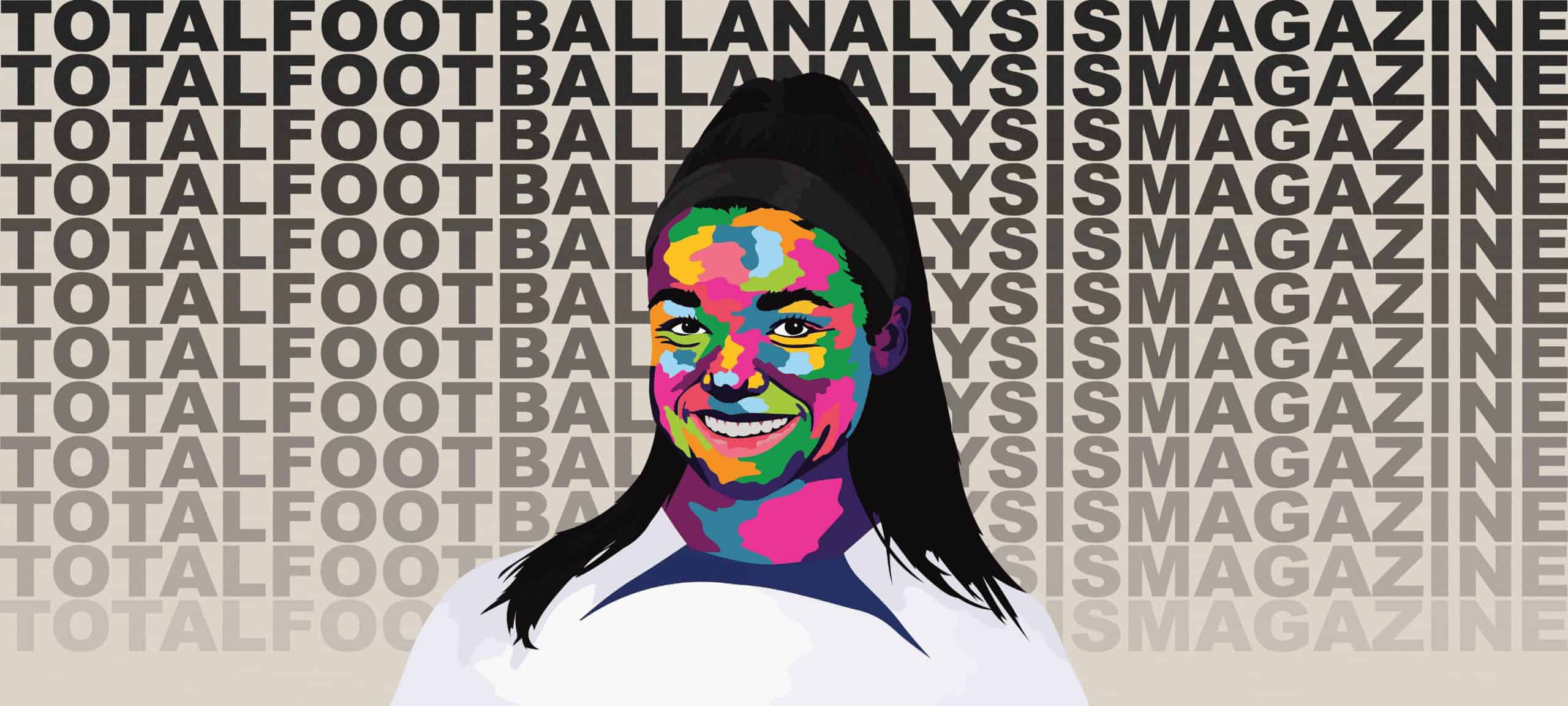



Comments